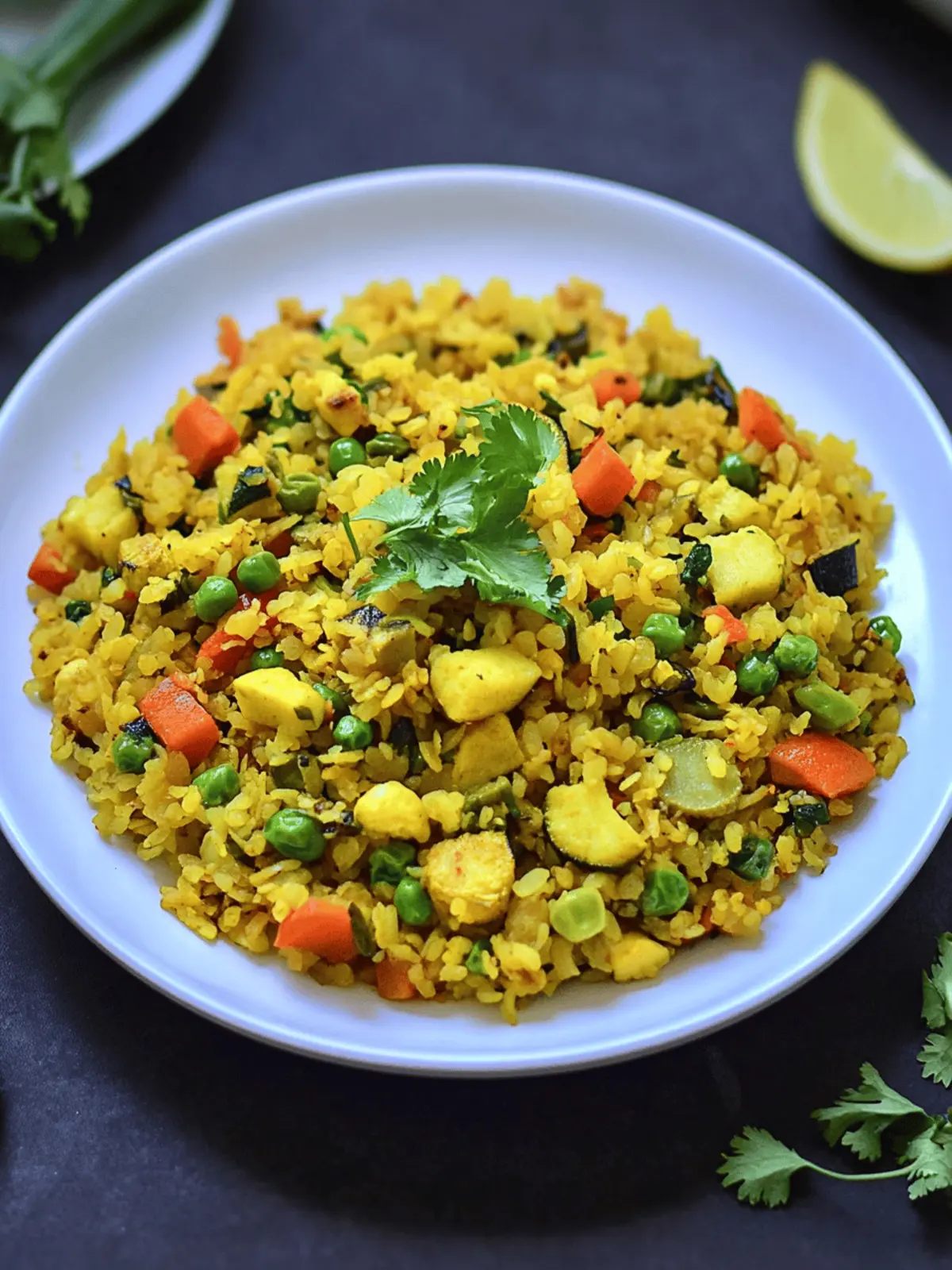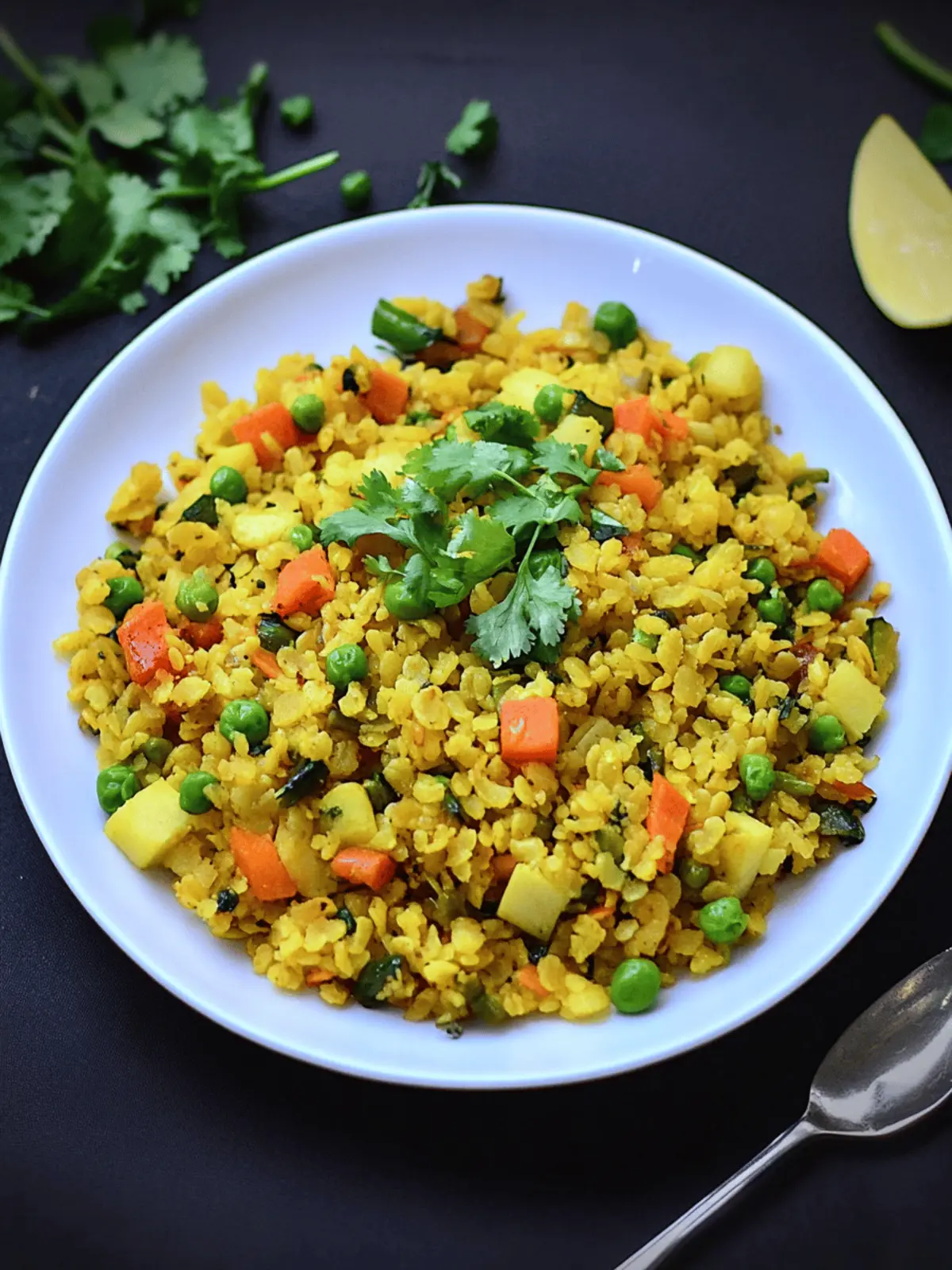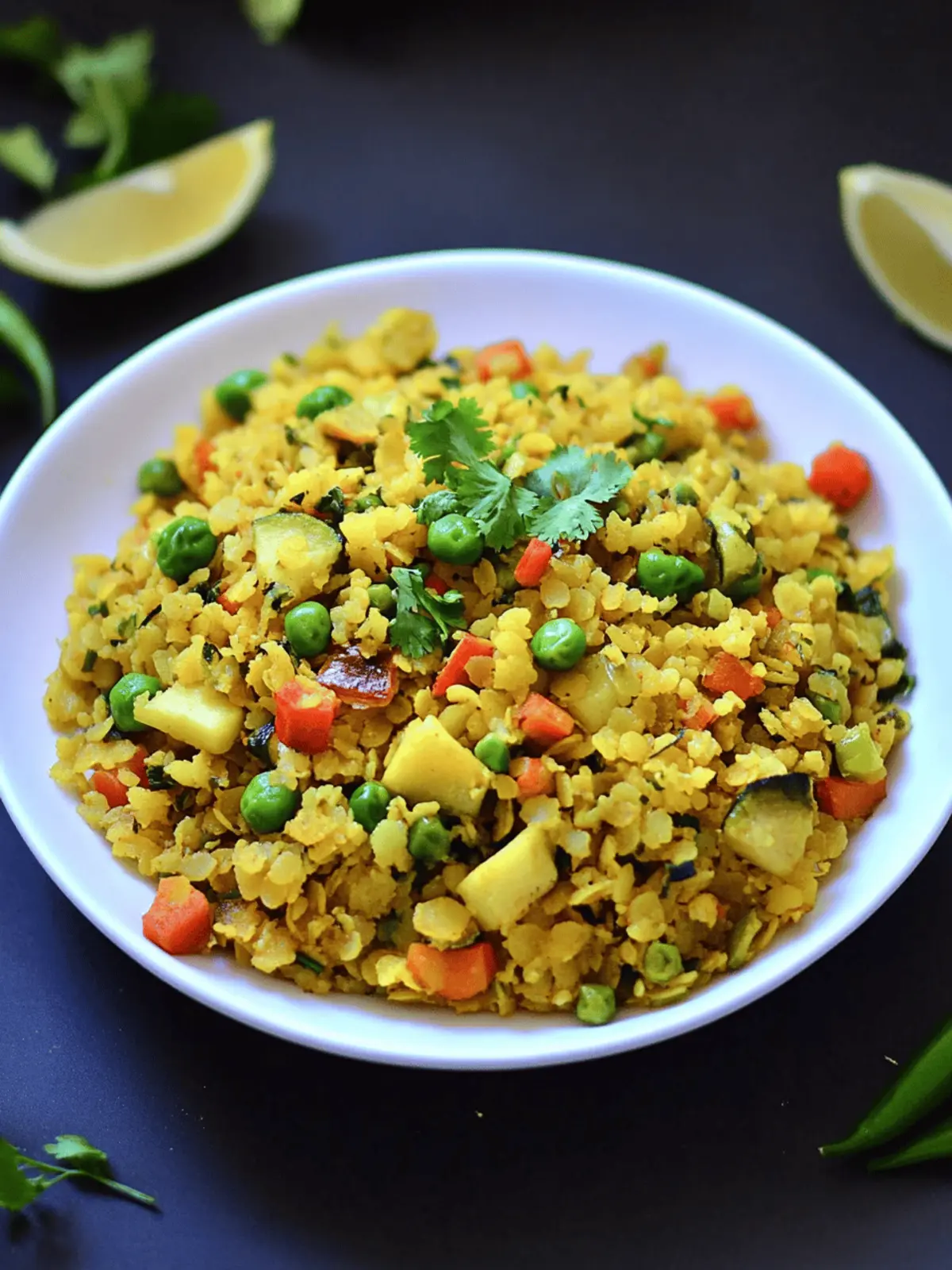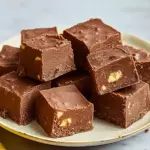There’s something truly uplifting about a colorful, nourishing breakfast that wakes you up and fuels your day. A while back, I found myself in need of a healthy option after too many mornings spent grabbing takeout or cereal. That’s when I tasted Vegetable Poha for the first time a vibrant dish that combines flattened rice with an array of fresh vegetables and protein-packed sprouts, all cooked to perfection in just under 20 minutes!
This low-carb Indian delight not only pleases the palate but also fills your bowl with fiber and essential nutrients. The delightful crunch of peanuts, the warmth of spices, and the zesty kick of lime all come together to create a satisfying start to my day. Whether you’re a busy professional or a parent juggling mornings, this Diet Poha is the ultimate solution to elevate your breakfast game. Let’s dive into the recipe and bring a burst of flavor and health to your table!
Why is Vegetable Poha the Best Breakfast?
Quick to Prepare: You can whip up this delightful dish in under 20 minutes, perfect for those busy mornings.
Nutrient-Packed: Loaded with colorful veggies and protein-rich sprouts, it’s a fiber-rich meal that nourishes your body.
Low-Carb Goodness: Satisfy your cravings without the guilt each serving is a low-carb option that won’t weigh you down.
Versatile Comfort: Tailor the recipe to your taste by swapping in your favorite vegetables; it’s endlessly adaptable!
Crowd-Pleaser: A hit among family and friends, this delicious twist on a classic will surely impress everyone at the breakfast table.
Vegetable Poha Ingredients
For the Base
• Poha / Flattened Rice – Use thick or medium variant; soak thick variant for 4-5 minutes for the best texture.
• Onion – Adds savory depth; substitute with shallots for a milder flavor if preferred.
• Green peas – Provides sweetness and protein; frozen peas work well too if fresh isn’t available.
• Carrot – Offers color and crunch; you can swap it with zucchini for a different texture.
• French beans – Brings a fresh, crisp element; green beans can serve as a suitable alternative.
• Capsicum – Adds slight sweetness and vibrant color; bell peppers are an excellent substitute.
• Potato – Contributes heartiness; omit for a lower-carb version without losing flavor.
• Cabbage – Adds fiber and bulk; feel free to use any leafy green instead.
• Moong bean sprouts – Boosts protein content, serving as a great source of vitamins; use lentil sprouts if unavailable.
• Green chillies – Infuses heat; adjust based on your spice tolerance or omit for milder flavors.
• Curry leaves – Introduces authentic flavor; bay leaves can be used as a substitute.
• Ginger – Enhances aroma and spice; freshly grated ginger is preferred for maximum flavor.
For the Tempering
• Coconut oil – Essential for tempering and flavor; feel free to use any light cooking oil if you wish.
• Mustard seeds – Core spice that adds flavor and crunch; essential for authentic poha.
• Cumin seeds – Provides warm, earthy notes that complement the dish beautifully.
• Chana dal and Urad dal – Contributes texture and a nutty flavor in the tempering; use either or a mix for added depth.
• Peanuts – Adds crunch and protein; cashews can also be used for a twist.
• Turmeric powder – Gives the dish a warm color and boasts anti-inflammatory properties.
• Hing / Asafoetida – Enhances flavor; you can skip this if it’s unavailable.
• Rock Salt / Sendha Namak – Traditional salt for fasting purposes; regular salt can substitute in everyday cooking.
For the Finishing Touch
• Coriander leaves – For garnishing and adding a fresh flavor at the end.
• Lime juice – Introduces tanginess that elevates the overall flavor of the Vegetable Poha.
With these carefully chosen ingredients, you’re set to create a delightful and nutritious dish perfect for breakfast—Vegetable Poha is sure to shine on your table!
How to Make Vegetable Poha
- Rinse poha: Start by rinsing the poha 2-3 times under cold water. This removes excess starch and prevents it from becoming too sticky. Set it aside for 10 minutes to drain off any remaining water completely.
- Prepare vegetables: While the poha is draining, take a moment to clean and chop all your vegetables into bite-sized pieces. Having everything prepped helps the cooking process go smoothly and quickly!
- Heat oil: In a deep pan, heat 2 tablespoons of coconut oil over medium heat until hot. Add mustard and cumin seeds, allowing them to splutter and release their delightful aroma.
- Fry dals and peanuts: Next, toss in 2 tablespoons of peanuts, along with 1 tablespoon each of chana dal and urad dal. Fry these until they turn golden brown, bringing a lovely crunch to your dish.
- Sauté spices: Add a handful of curry leaves, 2 finely chopped green chillies, and 1 tablespoon of freshly grated ginger to the pan. Sauté for about 30 seconds until they release their fragrant flavors.
- Cook onions and spices: Now, add 1 chopped onion, ½ teaspoon of turmeric powder, and a pinch of asafoetida. Sauté this mixture until the onions turn translucent, infusing the oil with these wonderful flavors.
- Incorporate vegetables: Next, mix in ½ cup of green peas and all the chopped vegetables, along with ½ teaspoon of salt. Cook until the veggies are tender yet vibrant in color.
- Add moong sprouts: Gently fold in ½ cup of moong bean sprouts, stirring them into the vegetable blend until everything is well combined and heated through.
- Combine poha: Carefully add the soaked poha to the pan, adjusting the salt to taste. Gently mix everything together, being cautious not to break the poha, ensuring a fluffy texture.
- Finish cooking: Cook on medium heat for an additional 4-5 minutes, allowing the ingredients to meld together. Keep an eye on the poha to ensure it remains separate and does not turn mushy.
- Garnish and serve: Turn off the heat, then drizzle with fresh lime juice and sprinkle chopped coriander leaves on top. Serve your Vegetable Poha hot for a delightful breakfast!
Optional: Serve with a side of yogurt for an extra touch of creaminess.
Exact quantities are listed in the recipe card below.
What to Serve with Vegetable Poha?
Elevate your breakfast experience with delightful pairings that complement this vibrant dish while adding a wholesome touch to your meal.
- Creamy Yogurt: A side of yogurt introduces a cooling element, balancing the spices and adding a creamy texture to each bite. The tanginess accentuates the flavors beautifully.
- Fresh Fruit Salad: Brighten up your plate with a mix of seasonal fruits. The sweetness and juiciness of fruits like mango or berries provide a lovely contrast to the savory Poha.
- Mint Chutney: A dollop of homemade mint chutney brings refreshing zing to your meal, enhancing the flavors of Vegetable Poha with its vibrant herbal notes.
- Masala Chai: Pair your breakfast with a warm cup of masala chai—spicy and aromatic, it complements the comforting flavors of Poha while invigorating your senses.
- Roasted Nuts: Sprinkle some roasted almonds or cashews on top for an added crunch and richness. They provide a delightful bite that enhances the nutritional value, making your meal more satisfying.
A combination of these sides will not only nourish you but also elevate the whole dining experience! Enjoy your table’s colorful array alongside your hearty Vegetable Poha.
Expert Tips for Vegetable Poha
- Fluffy Texture: Ensure poha is not soaked for too long; it should remain light and fluffy, not mushy.
- Vegetable Variety: Feel free to mix and match veggies based on your preference; use seasonal produce for the best flavor and nutrition.
- Even Cooking: A wide, deep pan allows for even cooking, preventing the poha from clumping together and ensuring it stays separate and fluffy.
- Cooking Time: Keep an eye on the cooking time; overcooking can lead to a mushy texture. Aim for a total of 4-5 minutes after adding poha.
- Adjust Spice Levels: Modify the amount of green chillies based on your heat preference; this allows you to cater the dish to your family’s taste.
- Proper Garnishing: Finish with fresh lime juice and coriander for an added burst of flavor, enhancing the overall enjoyment of your Vegetable Poha.
Vegetable Poha Variations & Substitutions
Feel free to bring your own twist to this delightful dish and experiment with flavors you love!
- Gluten-Free: Substitute poha with quinoa or millet for a gluten-free breakfast option. Both grains bring unique textures and flavors. Quinoa, in particular, adds an extra protein punch!
- Dairy-Free: Use a splash of olive oil or ghee instead of coconut oil for a different flavor profile. This small change can completely transform the taste while keeping it plant-based.
- Spicy Kick: For those who love heat, add chopped green jalapeños or a dash of red chili powder to intensify the spice level. Adjust according to your preference to make it just right!
- Nutty Flavor: Experiment with roasted sunflower seeds or pumpkin seeds instead of peanuts for a delightful crunch that’s also nut-free. These seeds will still provide that satisfying bite!
- Extra Protein: Mix in tofu scramble or scrambled eggs to enhance the protein content and make this dish even heartier. It’s a great way to keep you fuller for longer.
- Sweetness Factor: Toss in some raisins or grated coconut for a hint of sweetness that pairs beautifully with the savory elements. The contrast will surprise your taste buds!
- Leafy Greens: Blend in some chopped spinach or kale for extra nutrition and vibrant color. Leafy greens not only boost fiber but also add a lovely earthiness to the dish.
- Herb Infusion: Fresh mint or basil can replace coriander leaves for an aromatic twist. These herbs lend a fresh flavor, making each bite revitalizing and unique.
Let your culinary creativity flow with these variations and make this Vegetable Poha truly your own!
Make Ahead Options
These Vegetable Poha are perfect for busy home cooks looking to save time during hectic mornings! You can prep all your vegetables and even soak the poha up to 24 hours in advance. Simply chop the veggies and store them in an airtight container in the refrigerator. When you’re ready to cook, heat coconut oil in a pan and follow the usual steps from tempering the spices to combining the soaked poha. This ensures your dish is just as delicious and fresh—giving you that vibrant, hearty breakfast with minimal effort. Plus, it’s a great way to start your day on a nutritious note!
Storage Tips for Vegetable Poha
- Fridge: Store leftover Vegetable Poha in an airtight container in the refrigerator for up to 2 days. Make sure it’s completely cool before sealing to prevent condensation.
- Freezer: While not typically recommended, you can freeze Vegetable Poha for up to 1 month. To do so, place it in a freezer-safe container, but be aware that the texture may change upon thawing.
- Reheating: Reheat in a pan over low heat, adding a splash of water to restore moisture and prevent it from becoming dry or mushy. Stir gently until heated through.
- Serving Fresh: For the best taste and texture, enjoy your Vegetable Poha fresh; it truly shines when served immediately after cooking!
Vegetable Poha Recipe FAQs
What type of poha should I use for this recipe?
I recommend using thick or medium flattened rice (poha). If you’re using thick poha, soak it for 4-5 minutes; this helps achieve the perfect fluffy texture. The right choice ensures your Vegetable Poha is light and delicious!
How should I store leftover Vegetable Poha?
Store any leftovers in an airtight container in the refrigerator for up to 2 days. Make sure to let it cool completely before sealing the container to avoid any moisture build-up. When ready to enjoy, gently reheat it on low heat, adding a splash of water to restore its moisture.
Can I freeze Vegetable Poha?
Yes, you can freeze Vegetable Poha for up to 1 month! To do this, place the cooled dish into a freezer-safe container or bag. When you’re ready to eat, thaw it in the fridge overnight before reheating. Keep in mind that the texture may be slightly softer after freezing, so add a little water while reheating to bring it back to life.
How can I adapt this recipe for dietary restrictions?
Absolutely! To make it gluten-free, simply ensure your poha is labeled as gluten-free. For nut allergies, you can omit the peanuts and use sunflower seeds or leave them out entirely. Alter vegetables based on your preferences, and feel free to use oil substitutes if needed. Enjoy making it your own!
What if my poha becomes mushy while cooking?
If your poha turns mushy, it’s typically because it was soaked too long or overcooked. To remedy it, try spreading it out on a tray and letting it cool for a bit; this can help dry it out slightly. For next time, soak the poha just enough to soften it, and keep an eye on cooking times around 4-5 minutes after adding it should keep it fluffy!
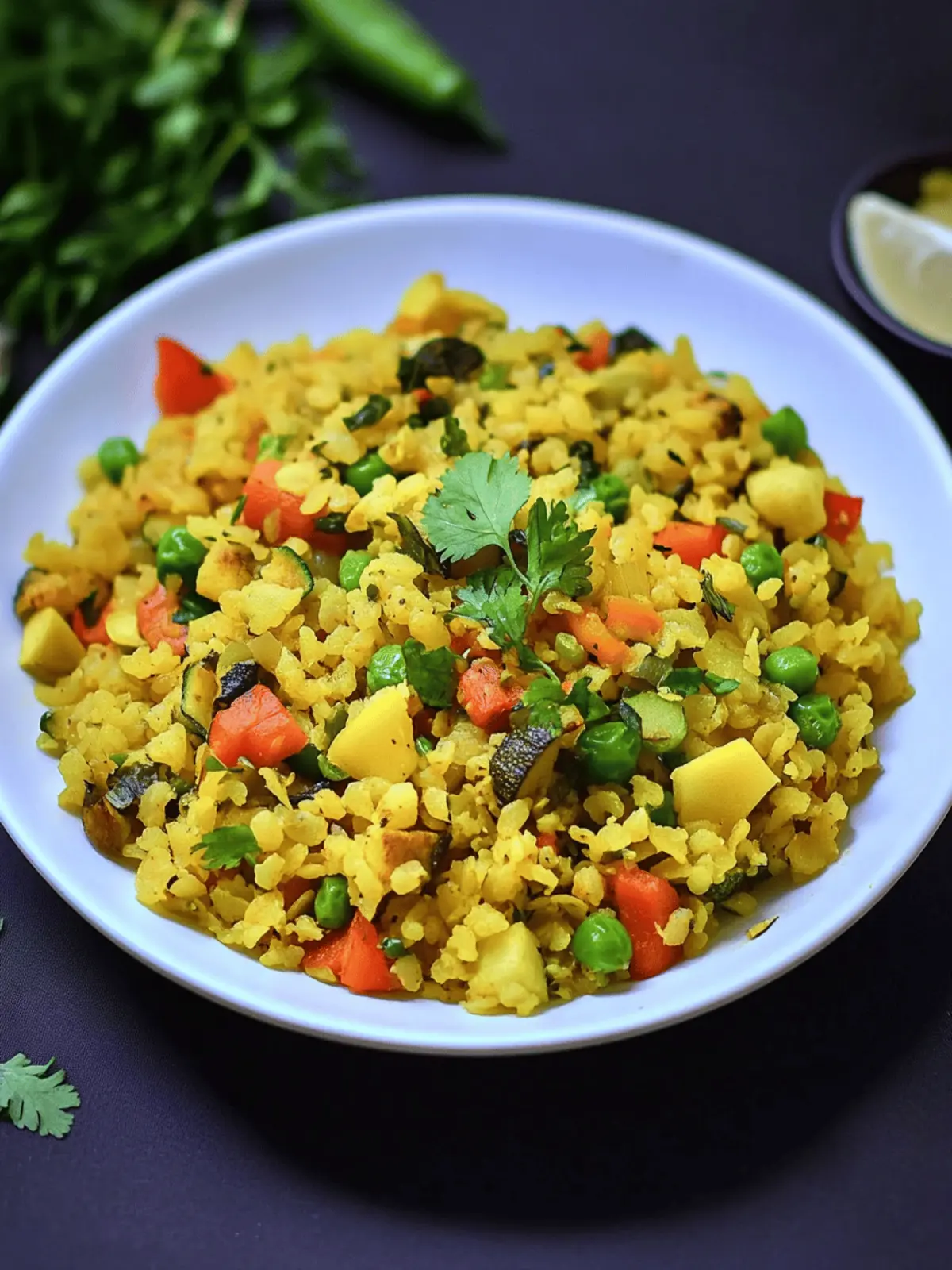
Delicious Vegetable Poha: Your Go-To Diet Poha Breakfast Recipe
Ingredients
Equipment
Method
- Rinse poha 2-3 times under cold water and set aside for 10 minutes to drain off excess water.
- Clean and chop all vegetables into bite-sized pieces.
- Heat coconut oil in a deep pan over medium heat; add mustard and cumin seeds.
- Add peanuts, chana dal, and urad dal; fry until golden brown.
- Add curry leaves, green chillies, and ginger; sauté for about 30 seconds.
- Add chopped onion, turmeric powder, and asafoetida; sauté until onions turn translucent.
- Mix in green peas and all chopped vegetables; cook until tender.
- Fold in moong sprouts, mixing until well combined.
- Add soaked poha, adjusting salt to taste; mix gently.
- Cook on medium heat for an additional 4-5 minutes.
- Turn off heat; garnish with lime juice and coriander leaves.

